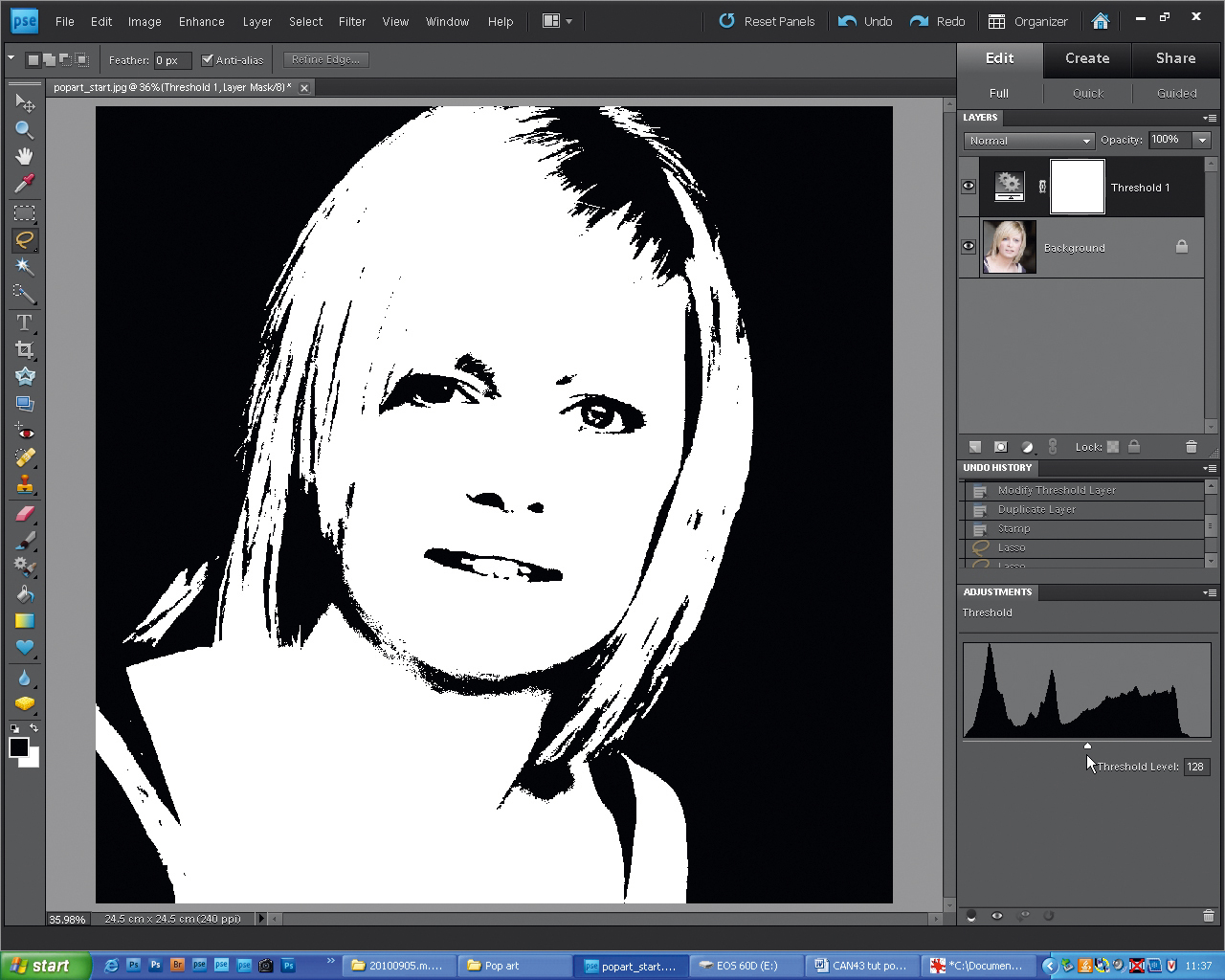His Mature Work Is Considered Pop Art and Sculptures Made From Found Objects Are Called
Make your own pop art portrait

Here we'll convert a bland portrait into a pop art masterpiece. It'southward a vivid way to get creative and enliven your forgettable shots. For this tutorial, we'll be using Photoshop filters, selection tools, Adjustment Layers and Layer Masks, and the Hue/Saturation command.
- Pop Art: 8 artists every designer should know
Y'all may have noticed that our first image isn't that precipitous! This is an added bonus of popular fine art images: you can apply images that would otherwise have been discarded.
01. Go far mono

First open up up your portrait in Photoshop. Go to 'Layer > New Adjustment Layer > Threshold', and set Threshold to about 128. To bring out more detail in the optics and mouth, select the 'Background' layer, go to 'Layer > Duplicate Layer'. From 'Filter > Sketch > Stamp', set Low-cal/Dark Rest to 26 and Smoothness to 1. Now use the Lasso tool to draw around the optics and oral cavity, holding downwards Shift to add to your selection each time.
02. Brighten your groundwork

Click Add together Layer Mask to create a mask out of your pick. Now to change the background colour from black to green. Highlight the top 'Threshold one' layer and use the Quick Selection tool to select the background either side of the figure. Concur Alt to subtract from your selection in order to tidy it up. Click the one-half-moon icon on the Layers palette, and select a Solid Colour Adjustment Layer.
03. Clean upward border detail

Cull a green from the Colour palette. To tidy the edges, utilize the Brush tool (press B) to paint over your Layer Mask to reveal detail beneath. Press D to change the default foreground/groundwork colour to white/black, press 10 to fix foreground colour to blackness, then pigment circular the edges of the hair if needed. Click X to toggle between a white/black brush if you need to paint the light-green background back in.
04. Brand the hair stand up out

To turn the hair bright xanthous, first grab the Magnetic Lasso tool. Starting time at the lesser-left of the hair and draw carefully effectually the outside edge. Use your artistic judgement when it comes to the inside strands and fringe! Keep cartoon until you reach your start indicate again, and click when ii modest circles appear to consummate the selection. Again create a Solid Colour Adjustment Layer, pick a yellow, and click OK.
05. Blend and castor

Use the drop-down menu in the Layers palette to gear up the Blending Mode to Multiply, revealing the hair outlines underneath. Reduce Opacity from 100% with the slider to lessen the colour'southward impact. Don't worry if your selection isn't slap-up – pop fine art should wait a trivial uneven! You can tidy it upward with a white/black brush over the Layer Mask to add together/remove the xanthous.
06. Adjust skin tones

Use the Quick Pick tool to select the confront, neck and chest. Ensure 'Sample All Layers' is ticked. Press Alt to remove areas such as shoulder straps from your selection. Then repeat as before; create a Solid Colour Adjustment Layer, choose a pink, ready Blending Mode to Multiply, arrange Opacity if necessary. Use a 30-pixel white/blackness castor to pigment over the Layer Mask and clean up any unwanted white bits.
07. Modify eye colour

To turn the eyes blueish, zoom right in (ctrl and +) and use the Lasso tool to draw around the iris of each middle. Then repeat the steps above to turn them blue, dropping Opacity downwards for more than realistic look, and again use Brush tool on a Layer Mask to tidy up any spilt ink! Do the aforementioned for the shoulder straps; we chose a purply-blue colour here.
08. Increase canvas size

To create more than versions, get-go go to 'Layer > Flatten Image', then 'File > Salvage As', and rename your file (we've used 'popart2.jpg'). Go to 'Image > Resize > Sheet Size'. To extend the sail, untick the Relative box, click the top-left arrow to anchor the prototype, and change to width 49cm and height 73.5cm for a portrait image. Finally, set up the Sheet Extension Colour to black.
09. Mix it up

Relieve this new paradigm with a new version name ('popart3.jpg'). Reopen 'popart2.jpg', and printing Ctrl+U to open Hue/Saturation. Merely move the Hue slider left or right to create a dissimilar coloured pop art epitome. Then use the Move tool to drag-and-drop your new popular art pic on to the blank canvas space on 'popart3.psd'.
ten. Put it all together

Go dorsum to 'popart2.jpg', open Hue/Saturation and repeat the above process until you have 4 or half dozen vibrant images on the 'popart3.psd' image. Move the images around on the canvas (highlighting the correct layer) so the images are in the best order and with no similar colours next to each other. Go to 'Layer > Flatten', and save it as a single-layered JPG.
Related articles:
- Colour in Photoshop: summit tricks
- Get creative with Photoshop Blend Modes
- Brilliant Photoshop tutorials
Related articles
Source: https://www.creativebloq.com/photoshop/make-your-own-pop-art-image-11121384